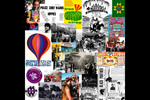|



| |
Kaliflower & the Homosexual Revolution of 1969
Intersecting Lives & the Rise of the Gay Liberation Movement in San
Francisco
Presentation to Burrow’s Bees Pandemic Zoom, September 24, 2023 (watch the
video recording here).
Some may question the juxtaposition of LGBTQ+ history and the Diggers. My
argument is that the San Francisco Diggers spawned a movement that spread
outward into the counterculture. Among the ripple effects in the San Francisco
Bay Area was the emergence of a group of communes devoted to Digger Free and
the vision of "Post-Competitive
Game of Free City" long after the Summer Solstice of 1968 brought down the
curtain on the original Digger energy in San Francisco. Many of these communes
were queer identified. It is critical to not overlook this crossover between
Digger and Queer history.—en
HOW TO ZOOM the images: click on any image to ZOOM IN; then click the full-size
image to ZOOM OUT.
|
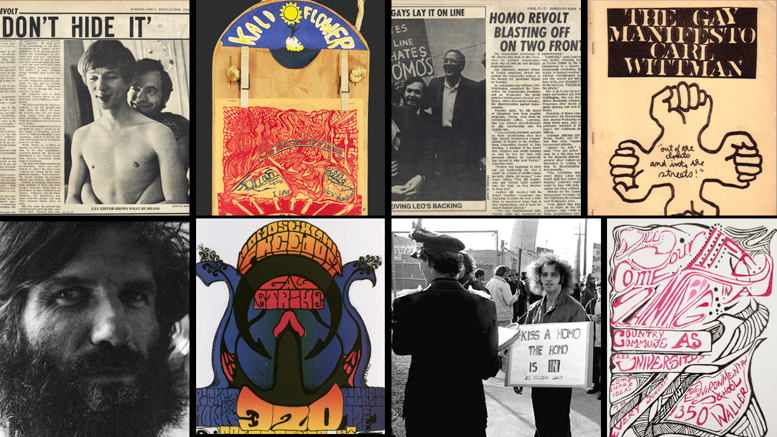 This project has been percolating a while. In our zoom group over the
past three years, we have talked about many of the people and groups in
this history, but never as a series of interconnected points along an
arc of social history. So, this presentation is an attempt to connect
Kaliflower, both the commune and the newspaper, with the emergence of a
radical queer sensibility in San Francisco. Everyone knows about
Stonewall and what happened in June of 1969 in New York City. But not
many know what happened in San Francisco several months earlier.
Stonewall has become that watershed moment that divides two eras in the
history of queer freedom. As well it should be. However, as we will see,
a fully articulated notion of gay liberation had been formulated in San
Francisco months before Stonewall. And the interesting aspect of this
research is how it intersects with the history of Kaliflower.
|
 The presentation of David Parkhurst’s recently uncovered photographs from 1967
to 1970 inspired this talk. David narrated the photos that Joseph Johnston had
developed from the long-lost negatives. David told how he first arrived in San
Francisco at the height of the Summer of Love. He has photos of the
Communication Company, the Diggers, Straight Theater people, and later the
Sutter Street Commune. One of David’s stories prompted me to do a deep dive
researching this presentation. David told how he was brought to the commune by
Dunbar Aitkens after the two of them ran into each other on Haight Street in
March 1969. One of the oddities of the story is that David and Dunbar ran into
each other in 1969 on the exact same corner as they had two years previously. On
both occasions, Dunbar was handing out leaflets about the current project he was
pursuing. On this second occasion, David remembers that Dunbar was handing out a
leaflet announcing a free university for communes.
|
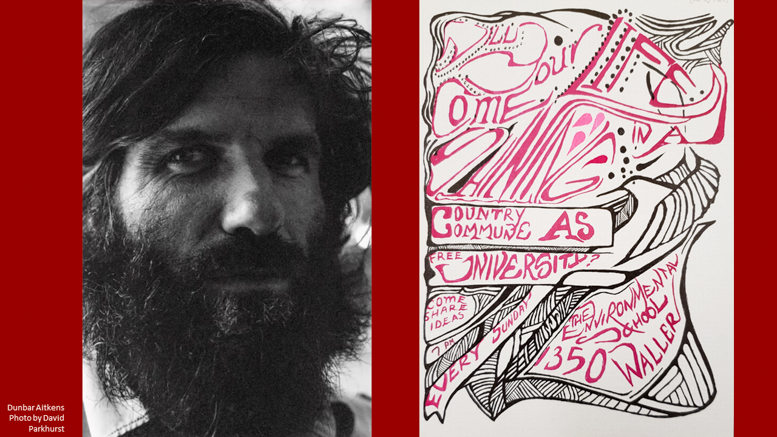 The flyer on the right is for “The Environmental School Free University” —
Dunbar’s project when he and David randomly met each other in 1969. David’s
recollection of Dunbar set me off on this research trail and it turns out that
Dunbar intersects this history at several points. The best description of Dunbar
comes from Irving Rosenthal’s memoir for the tenth anniversary issue of
Kaliflower. Irving wrote:
“I saw Dunbar Aitkens on Haight Street handing out mimeographed sheets
long before I met him, and I met him long before he moved into the commune.
Dunbar was a huge, tall, blackhaired street philosopher, as gentle as a
bunny. He was very interested in young men, and had the knack for meeting
them easily on the street. He always had some interesting project going to
talk to them about. He brought many of them to the commune, both before,
during, and after the month he lived with us (March-April 1969), to the
point where the word “indunbaration” was coined to describe the phenomenon.
At the time he came to live with us he was trying to form a sort of rural
commune called the Environmental School, along with Stevie and Teddy, whom
he brought into the commune with him. Other Dunbar-recruited members were
Art, Carl, Arthur, Sam, and David. Dunbar hotly denied any religious
outlook, but I always saw him as a roving guru, making spiritual contact on
the street.”
As Irving mentioned, Dunbar was responsible for David Parkhurst moving into
the commune. At their chance meeting on Haight Street, Dunbar told David he was
living in a commune, and he should come by to visit. That was the Sutter Street
Commune, which had set up and was operating the Free Print Shop after the Diggers
convinced Irving to bring his press from New York. The flyer announcing Dunbar’s
Free University project was printed by the Free Print Shop.
|
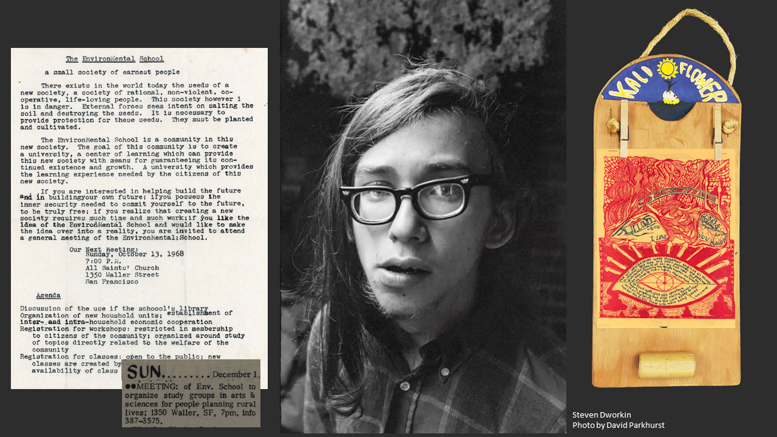
Steven Dworkin was another one of Dunbar’s recruits for the commune. In late
1968, Steven attended Dunbar’s weekly gatherings for the Environmental School
that were held at the All Saints Church on Waller Street. As an aside, this
church was one of the locations out of which the Diggers had operated. It was
where Walt Reynolds taught the Diggers how to bake whole wheat bread in
discarded coffee cans. In late 1968, at one of Dunbar’s meetings, the Sutter
Street commune showed up to check out the Environmental School Free University.
This is when Dunbar and Steven met the commune. Dunbar soon decided to accept
the commune’s invitation to move in, and Steven followed within a short time.
With a little prompting, Steven had a brainstorm idea for a new project —
to publish an intercommunal newspaper to stay in contact with other communes in
the Bay Area. He named the newspaper Kaliflower as a pun on the term Kali Yuga
which, in Hindu cosmology, is the end times of destruction.
The first issue of Kaliflower was April 24, 1969. It was distributed to a
handful of communes. A copy of the first issue can be seen hanging from
clothespins on the Kaliflower plywood board, another of Steven’s inventions.
Each commune would have a Kaliflower board hanging in the kitchen where the
weekly issue would be attached. The cover of this first issue would set the tone
for the homoerotic imagery that became one of the hallmarks of Kaliflower. Even
though the commune was a mix of sexual orientations, it had the reputation of
being a gay commune. With creatures like Hibiscus and Jilala and Ralif dressing
up and performing as the Kitchen Sluts while preparing the communal meal every
night, it’s hard not to see how that reputation was gained. Over the period of
three years of continuous weekly publication, Kaliflower grew from a handful to
more than 300 communes that received the Free newspaper which was hand delivered
every Thursday.
|

Meanwhile, in the same week as the first issue of Kaliflower, an essay appeared
in Vector calling for gay revolution. Vector was the publication of S.I.R., the
Society for Individual Rights, one of the half dozen homophile organizations at
the time. S.I.R. was founded in San Francisco in 1964 after police closed a
dozen bars with gay and lesbian customers. By 1969, S.I.R. had more than a
thousand members. In the April 1969 issue of Vector, the magazine’s new editor,
Leo Laurence, wrote a column in which he called for a radical new approach to
gay rights. He criticized gay establishment organizations, including S.I.R., for
their cautious attitudes toward radical advocacy, getting waylaid by ego-trips
and hypocrisy. He criticized the Tavern Guild for racism, citing their
opposition to Cititzen’s Alert, a project initiated by the Reverend Cecil
Williams, the Black head minister of Glide Church to end police harassment and
brutality. Laurence ended his essay with a clarion call that rang loud, and
which foreshadowed similar language a decade later from Harvey Milk. Laurence
wrote, “Individual homosexuals must open up and honestly accept their own
homosexuality. Say you’re gay at work, at home, church, wherever you go. Come
out from behind a double-life of straight at work and home, but gay at night.
I’ll admit it's not easy to be honest, but neither was writing this article.”
The same day that the April issue of Vector hit the newsstands, the Berkeley
Barb published an article that reported on its revolutionary message. Its lead
in sentence read, “The largest gay organization in the United States has been
challenged to join the revolution ‘today not tomorrow.’” In the photo
accompanying the article appeared Leo Laurence with his arms embracing a young
shirtless friend who was unnamed.
|
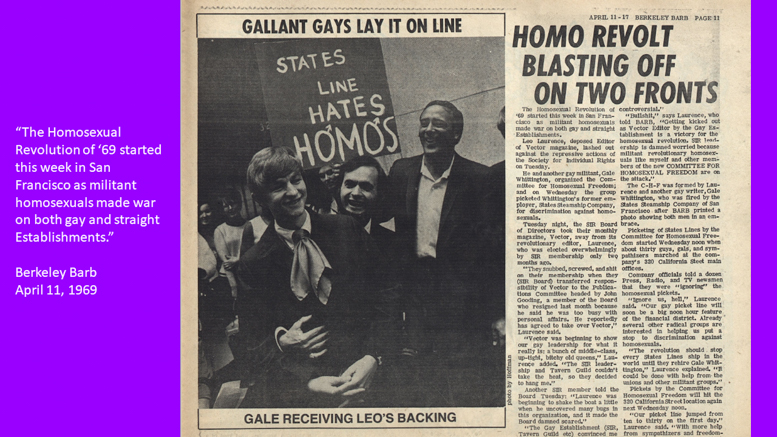
At this point, things start to move into high gear. The young friend who had
appeared shirtless in the Berkeley Barb was Gale Whittington, an employee of the
States Steamship Company at their headquarters in San Francisco’s financial
district. Whittington was fired from his job the week after his photo appeared
in the Barb. Laurence and Whittington then decided to form a group to protest
the firing by holding a daily picket line in front of the Steamship Company
offices on California Street. They named their group the Committee for
Homosexual Freedom. Here’s an article in the Berkeley Barb with a report of the
protest. The article announced that, “The homosexual revolution of 1969 started
this week in San Francisco as militant homosexuals made war on both gay and
straight Establishments.” The article also reported that the Board of Directors
of S.I.R. had dismissed Leo Laurence as editor of Vector, a post he had held for
only two months.
|
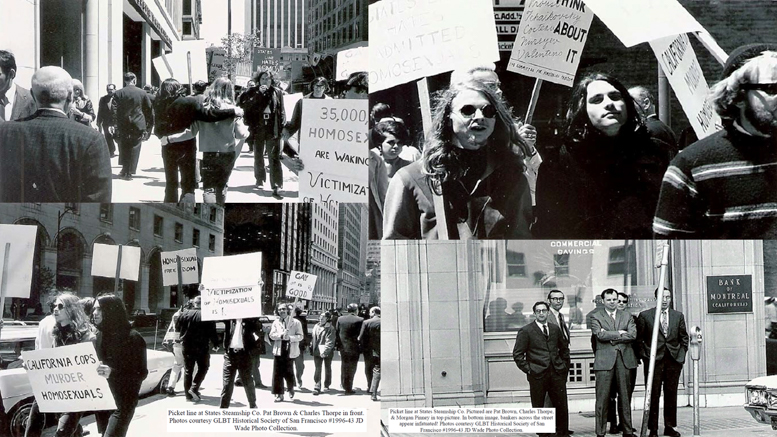
The next two slides depict many of the subsequent protest actions that the
Committee for Homosexual Freedom carried out in the spring, summer, and fall of
1969. Aside from the daily picket lines in front of 320 California Street to
protest the firing of Gale Whittington from his job, the committee joined or
initiated protests all over the Bay Area. This first slide is all photos of the
California Street picket line in front of the States Steamship headquarters. The
photo of the Financial District businessmen standing around is humorous on a
couple of levels. Whittington captions the photo “bankers across the street
appear infatuated.” If anyone remembers the Digger film NOWSREAL, there is a
similar scene. On the Summer Solstice 1968, one year earlier than these photos,
the Diggers drove up Montgomery Street with a troupe of belly dancers performing
on a flat bed truck. In the film, a gaggle of businessmen stand on the sidewalk
ogling the dancers. The fashion of the businessmen hadn’t changed in one year
although the protesters certainly had.
|
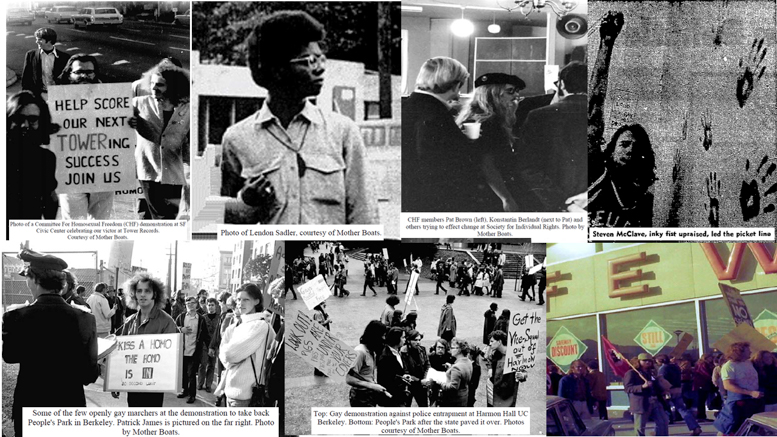
The Committee for Homosexual Freedom was very active in the following months of
1969, holding picket lines at Tower Records in San Francisco to protest the
firing of another gay employee; showing up with pro-gay signs at the People’s
Park demonstrations; picketing Safeway in solidarity with Cesar Chavez and the
Grape Boycott of the Farm Workers union. The campus at UC Berkeley, like for so
many movements in the past decade, was an ideal location for getting their
message out. One of the photos here was taken at Sproul Plaza protesting police
entrapment of gays on campus. Committee members also showed up at S.I.R.
meetings to lobby for more progressive policies. Also included is a photo of
Lendon Sadler, an active member of the Committee, to show what he was doing
before his involvement with the Cockettes the following year.
The photo at top right depicts a protest at the San Francisco Examiner on
October 31, 1969. The Committee for Homosexual Freedom set up a picket line to
protest an article by Robert Patterson, an Examiner reporter, that purported to
be an expose of San Francisco’s gay clubs where “homosexuals gather for their
sick, sad revels.” As the picket line proceeded in front of the Examiner
building on Fifth Street, with chants of “Say It Loud, We’re Gay and We’re
Proud,” suddenly a bag of purple printer’s ink was hurled over the roof onto the
protesters. The picketers proceeded to dip their hands into the ink and leave
handprints and slogans on the side of the building. At this point, the Tactical
Squad was called in and a dozen arrests were made. The Chronicle report of the
protest noted that “the homosexuals … prefer to be called gay.” In subsequent
reports of the arrests and follow-up court hearings, the name of the organizing
group shifted from the Committee for Homosexual Freedom to the Gay Liberation
Front. The reason for this change in nomenclature will become clear with the
next slide.
|
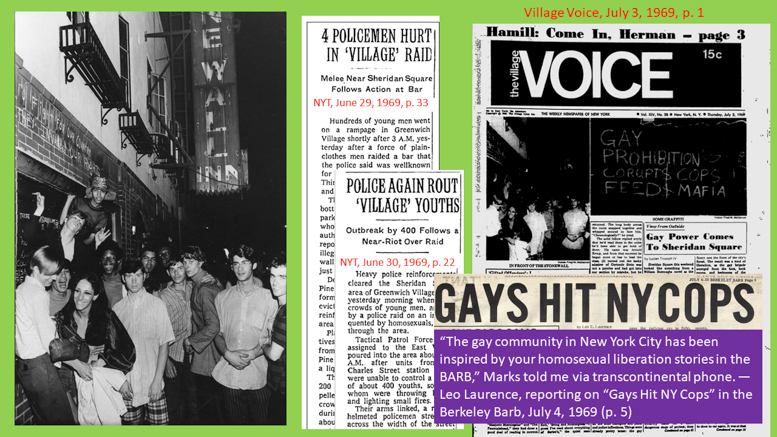
Remember that the first action of the Committee for Homosexual Freedom took
place in the first week of April 1969, nearly three months before Stonewall. Of
course, the events that happened in New York City in the early midnight hours of
June 28 would become a prime focus for historians of the Gay Liberation
movement. For a historian of social movements, it’s often an exercise in
futility to try and pinpoint causality. Did the events in San Francisco three
months prior to Stonewall play any part in the events that hot summer night in
Greenwich Village three thousand miles away? In reading through the underground
press, the only mention of the Committee for Homosexual Freedom in San Francisco
was the articles in the Berkeley Barb. I found nothing in the East Village
Other, for example, one of the sister underground papers that all shared their
stories through the Underground Press Syndicate.
But there are two tantalizing bits of evidence of a connection. Leo Laurence
reported on the Stonewall Uprising in the July 4, 1969, issue of the Berkeley
Barb. In the story, he reported talking with J. Marks, an eyewitness to the
second night’s events. Laurence quoted Marks as saying, “The gay community in
New York City has been inspired by your homosexual liberation stories in the
BARB.” Gale Whittington in his memoir states that “several” Stonewall activists
contacted the San Francisco group to say they took inspiration from the militant CHF activities that spring. “They said if we could do it here, they could stand
up for their rights there.” One of the outcomes of the Stonewall Uprising in
June was that a group of activists in New York City came together two nights
later and formed the Gay Liberation Front which had a more pronounced
revolutionary ring to it than Committee for Homosexual Freedom. Over the next
few months both CHF and GLF were used interchangeably until finally GLF became
the name of choice.
|
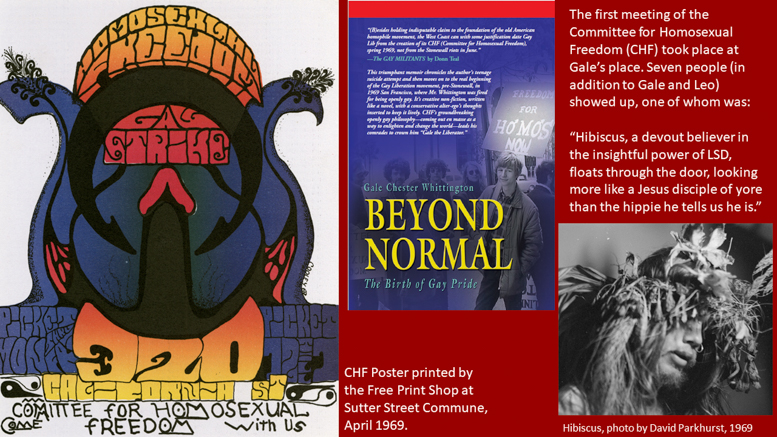
At this point, some of the intersecting connections in this story start to
resolve. One of those connections is this poster which the Free Print Shop
printed for the Committee for Homosexual Freedom early on for the picket line at
the States Steamship company. This poster is so interesting to me because it
represents a crossover between the queer and hippie cultures. The homoerotic
imagery combined with the psychedelic lettering and design is emblematic of the
mix between these two subcultures in San Francisco. At the Cockettes 50th
anniversary celebration, John Waters talked about the first time he attended one
of the Cockettes shows at the Palace Theater. Waters said, “I was so amazed at
the audience which was as shocking as the show. Hippie gay guys, finally! It was
so great to see them, you know. And drag queens with beards reading Lenin.”
Can people read the psychedelic lettering? “Homosexual Freedom / Gay Strike /
Picket Mon Thru Fri / 12 till 1 / 320 California Street / Committee for
Homosexual Freedom / Come With Us.” I have always wondered what the connection
was between the Sutter Street commune, the Free Print Shop, and the Committee
for Homosexual Freedom. The artist signed their work so someone brought the
design to the commune to print.
In preparing this talk, I discovered that Gale Whittington published a memoir in
2010. It contains a day-by-day account of his firing and subsequent actions.
After he was fired from his job when his shirtless photo appeared in the
Berkeley Barb, Gale and Leo Laurence went to complain to Max Scherr, the
publisher of the Barb. Scherr had used the photo without Gale’s or Leo’s
permission. Instead of apologizing, Scherr roused the two to action, suggesting
they protest the firing. That’s when Leo and Gale decide to form the Committee
for Homosexual Freedom. At their first organizing meeting, seven people showed
up besides the two founders. One of these new members was Hibiscus who was still
living in the Sutter Street Commune. Gale describes Hibiscus as “a devout
believer in the insightful power of LSD.” According to Whittington, Hibiscus was
a regular participant in the committee’s protests, at one point defusing a group
of teenagers bent on attacking the group by tearing off the placard of his
protest sign and leaving just the wooden picket to defend himself. The teens got
back in their cars and sped off.
Was Hibiscus the connection between the Committee for Homosexual Freedom and the
Free Print Shop’s printing of the crossover queer hippie poster? We can only
speculate. No one from the commune that I have asked remembers this poster. But
that’s not unusual given the amount of printing that was happening and the
weekly schedule for publishing Kaliflower.
|
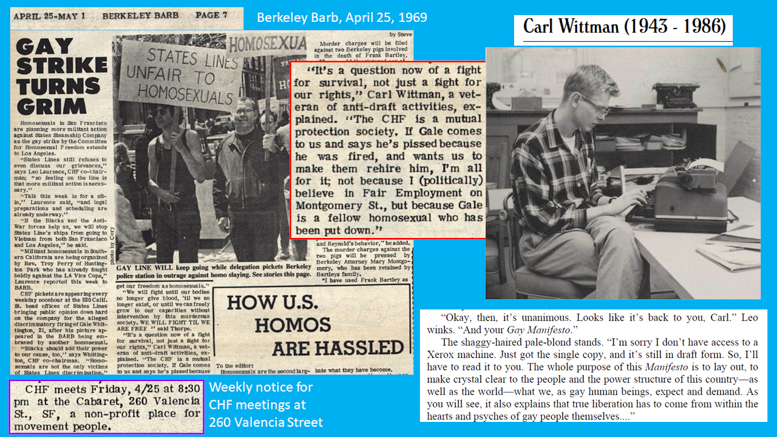
The next person whose story intersects with this history is Carl Wittman, who
was living in San Francisco when the Committee for Homosexual Freedom started
picketing States Lines. Carl had been a campus organizer for SDS, Students for a
Democratic Society, before coming out as gay and coming out to the West Coast.
Within the first week of the picketing, Carl showed up to join in. He announced
to the group that he was writing a manifesto of gay liberation and wanted to
share it with everyone. Here is an article from the Berkeley Barb two weeks into
the picketing that reports on the group’s plans to increase pressure on the
Steamship line. It is also the first article that quotes Carl Wittman who said,
“It’s a question now of a fight for survival, not just a fight for our rights.
The CHF is a mutual protection society.” In the lower left is one of the weekly
notices that appeared in the Berkeley Barb announcing the meetings that the CHF
held at 260 Valencia Street in San Francisco’s Mission district. Gale
Whittington in his memoir names many of the early members of the radical group.
I’ve mentioned Hibiscus but others included Pat Brown, a “self-proclaimed
Trotskyite hippie”; Charles Thorpe, Stephen Matthews, Morgan Pinney, Sheeza
Mann, Darwin Dias, Lendon Sadler, and Konstantin Berlandt. Carl got to read a
draft version of his manifesto to the group at one of their meetings. Gale
Whittington recalled Carl’s introduction, “The whole purpose of this Manifesto
is to lay out, to make crystal clear to the people and the power structure of
this country — as well as the world — what we, as gay human beings, expect and
demand. As you will see, it also explains that true liberation has to come from
within the hearts and psyches of gay people themselves.”
|
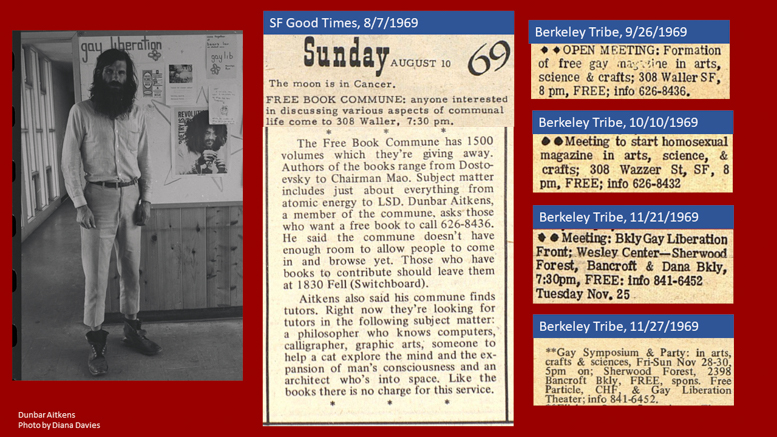
At this point, Dunbar Aitkens reemerges on the arc of this history. Recall that
Dunbar had lived briefly at the Sutter Street Commune just as Kaliflower, the
intercommunal newspaper, began publication. Dunbar, as Irving said, “always had
some interesting project going.” After he left the commune, we can pick up
traces of his activities in the summer and fall of 1969 through notices he
placed in the underground newspapers. His first project was a Free Book commune
he started on Waller Street. They collected and gave away books to all comers.
Here’s an article in the San Francisco Good Times that describes the range of
books they were giving away “from Dostoevsky to Chairman Mao.” Within a month,
Dunbar had started putting up notices for meetings at his commune to discuss a
journal of the arts, science and crafts by and for homosexuals. Finally, in late
November, Dunbar announces a weekend-long Gay Symposium and Party at Sherwood
Forest, the informal name for the Methodist student center across from the
Berkeley campus. Notice that the sponsors of the Gay Symposium are listed as
Free Particle, CHF and Gay Liberation Theater. Free Particle was Dunbar’s
journal by and for homosexuals. CHF of course was the Committee for Homosexual
Freedom. Gay Liberation Theater was a collective that included Gale Whittington
who were performing street theater on the Berkeley campus.
|
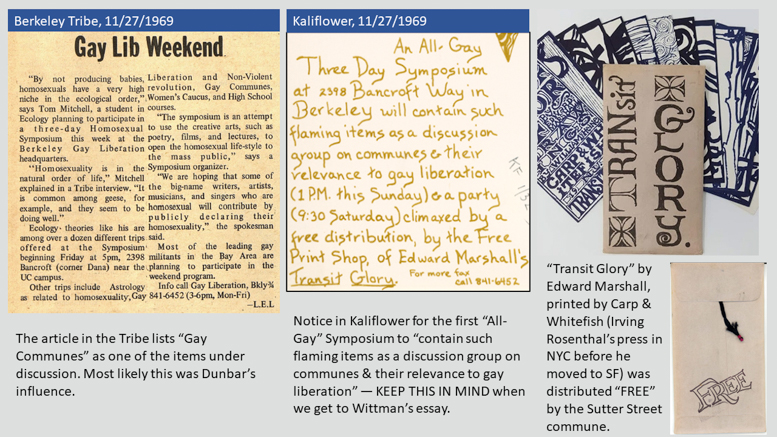
Here are two other notices about the first Gay Symposium that Dunbar and others
organized for the weekend of November 28-30, 1969. The Berkeley Tribe mentions
that topics to be covered include gay communes. The notice in Kaliflower states
that the symposium will “contain such flaming items as a discussion group on
communes and their relevance to gay liberation.” This symposium was where the
Sutter Street Commune distributed Edward Marshall’s book Transit Glory. Anyone
who heard my talk on the life and times of Irving Rosenthal may recall that this
was one of two Beat poetry books that Irving printed in New York in 1967 at his
Carp & Whitefish press and which presented a dilemma for Irving when he
converted to the Digger Free philosophy. Ultimately, the poet and writer Richard Brautigan convinced Irving to give away both books for free. The commune
distributed the Whelan book, Invention of the Letter, during a Free City poetry
reading at Glide Church the year before. Notice the envelope in which the
individual cards that made up the Marshall book were enclosed. The label FREE
was stamped on by the commune to signify its liberation from the world of
commerce. Nevertheless, Transit Glory is much sought after by collectors today
and fetches hundreds of dollars in the rare book market.
|

The Berkeley Barb reported that the attendance at the All-Gay Symposium was over
800 people. Success breeds success. A month later, a second All-Gay gathering
took place. This time, all three of our actors came together in pulling off the
event. Carl Wittman coordinated a one-day conference sandwiched in between the
four-day symposium organized by Free Particle. In turn, Free Particle is
mentioned as an offshoot of the Committee for Homosexual Freedom. Carl Wittman
is quoted saying, “The symposiums are the first stage in getting our shit
together as a gay radical community. They are valuable as a means of turning
people on to Gay Lib, especially from the campus community.” So sayeth the ex-SDS
organizer.
|
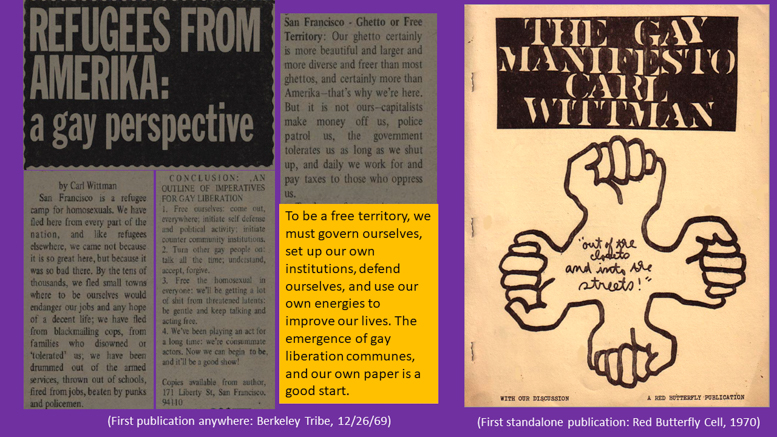
As if to bring this first phase of the homosexual revolution to a resounding
close, Carl Wittman’s essay was published on December 26, 1969, the same week as
the second All-Gay Symposium. After its first appearance in print in the
Berkeley Tribe, Carl’s essay was reprinted in numerous underground newspapers,
anthologies, magazines and standalone pamphlets. The Tribe published Carl’s
essay with a title, “Refugees from Amerika: a gay perspective.” The word America
was spelled with a K as was common in the radical 60s. In future reprintings,
the essay would be called simply "The Gay Manifesto." It has been described as
“the Bible of gay liberation” by some historians. I have highlighted what I
think is the crux of Wittman’s idea: “To be a free territory, we must govern
ourselves, set up our own institutions, defend ourselves, and use our own
energies to improve our lives. The emergence of gay liberation communes, and our
own paper is a good start.”
Attempting to unpack that statement is what this whole presentation has been
about. In that one sentence we see echoes of the Digger Free City project, the
Kaliflower intercommunal project, and the queer aesthetic and radical program
that emerged in the spring of 1969 in San Francisco and burst forth on the
national stage in New York a few months later. Was Wittman specifically
referencing Kaliflower? We cannot and may never know the answer to that
intriguing question. However, it is clear that the culture which Kaliflower,
both the commune and the newspaper, was attempting to build certainly fits into
Wittman’s vision for the queer community.
|
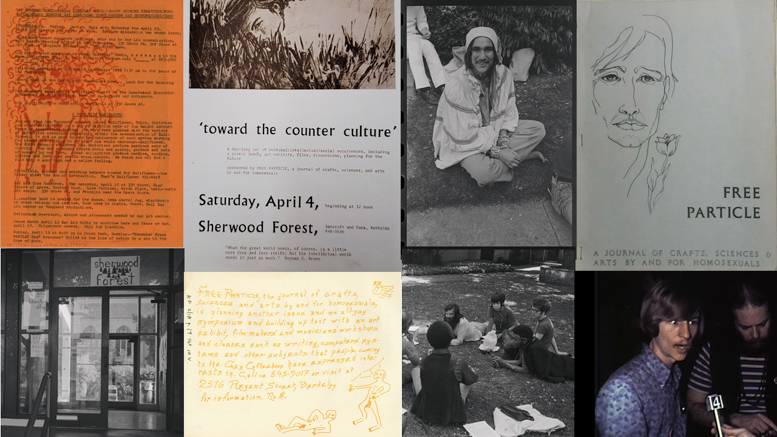
The publication of Carl Wittman’s “Gay Manifesto” might be considered the end of
this story but of course there is never an ending to any story even if
reverberations are all that remain. Echoes of the Homosexual Revolution of 1969
would continue to reverberate for decades.
This slide depicts a few of those echoes from the following
year, 1970. From top left, the orange sheet was a report on Gay Commune
Consciousness that was distributed with an issue of Kaliflower. The
poster for the event ‘toward the counter culture’ was printed by the Free Print
Shop at the Sutter Street Commune. It announced a “day long set of
cultural/intellectual/social occurrences” sponsored by Free Particle to
take place at Sherwood Forest. The three black and white photos are from that
event. The bottom left shows the informal name Sherwood Forest hanging over the
doorway of the Wesley Center. The bottom black and white photo shows Dunbar in a
group discussion on the lawn and the top photo shows Tahara who would become one
of the core members of the Angels of Light Free Theater commune.
In the same month as this symposium, the first and only
issue of Free Particle appeared, the cover of which is shown here. The
publication ran 60 pages and contained a wide range of topics. One of the most
interesting pieces is a script for one of the street theater skits that the Gay
Liberation Theater collective performed in Sproul Plaza in October 1969. Street
theater in the Sixties was so often improvisational that it is rare to find full
scripts. That this was also associated with the emerging gay liberation movement
makes it all the more valuable.
In the lower row in yellow ink is an ad from Kaliflower
announcing a Gay Coffee House and mentioning plans for another issue of Free
Particle but it never happened. By that point, Dunbar was off to other
pursuits. Carl Wittman was off to Oregon to live in a country commune and put
his literary skills in the service of RFD magazine. Gale Whittington never got
his job back and eventually left San Francisco for Colorado but not before
further rabble rousing as a gay activist. Gale is seen in the lower right being
interviewed by a local news station during a sit-in at the mayor’s office
protesting San Francisco police brutality against gays. This was a film clip
from a TV news archive that David Weissman and Bill Weber used in their
documentary film The Cockettes. Little did they know who Gale Whittington
was. In his memoir, Whittington proudly mentioned his appearance in The
Cockettes film not realizing that his role in the rise of gay liberation had
been lost to history.
With this presentation, I hope to have reconnected the intersecting lives and
roles that Leo Laurence, Gale Whittington, Dunbar Aitkens, and Carl Wittman
played in our collective history.
|

If you enjoyed this presentation, be sure to check out my website, The Digger
Archives, dedicated to keeping people’s history alive. To end this video, I want
to play an excerpt from a song* that embodies the sentiment that Leo Laurence
first announced in his Vector editorial half a century ago, “Individual
homosexuals must open up and honestly accept their own homosexuality. Say you’re
gay at work, at home, church, wherever you go.” The next screen is a listing of
some references for anyone who wants to follow up on the sources for this talk.
*A short excerpt of Lady Gaga’s “Born This Way” played over the last slide.
|
References
- Berkeley Barb available at
Independent Voices of JSTOR
- Beyond Normal: The Birth of
Gay Pride by Gale Whittington (self-pub., 2010) Kindle.
- Carl Wittman references:
- David Parkhurst Photographs (digital copies available offline
through photographer)
- Diana Davies
photographs of Berkeley Gay Symposia, at New York Public Library
- Free Particle, a Journal of Crafts, Sciences & Arts By and For
Homosexuals, April 1970 (available offline at the Digger Archives)
- Free Print Shop Archives
catalog
- Kaliflower,
the Intercommunal Newspaper
- On Christopher Street: Life,
Death, and Sex After Stonewall by Michael Denneny (University of Chicago Press,
2023)
- “The Gay Manifesto” by Carl
Wittman (available online at the University of Washington library
- The Stonewall Riots: A
Documentary History, ed. Marc Stein (New York University Press, 2019)
- THE LAST SLIDE: “Born This Way” lyrics and song by Lady Gaga
(Streamline Label)
|
|
